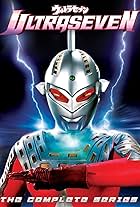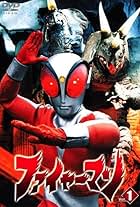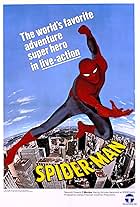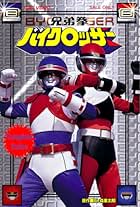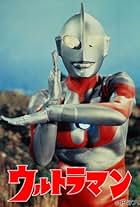Aggiungi una trama nella tua linguaSent by the Nebula Star to defend the Earth, a super-cyborg fights mutated pollution monsters created by the evil space-simians Gori and Rah.Sent by the Nebula Star to defend the Earth, a super-cyborg fights mutated pollution monsters created by the evil space-simians Gori and Rah.Sent by the Nebula Star to defend the Earth, a super-cyborg fights mutated pollution monsters created by the evil space-simians Gori and Rah.
Sfoglia gli episodi
Trama
Lo sapevi?
- QuizTetsuo Narikawa was a karate master and helped to found the Japanese karate league. Despite this he never used his karate skills in the series. The action scenes with Spectreman were played by Koji Uenishi who also played Kara the gorilla.
- ConnessioniFeatured in The Creature Wasn't Nice (1981)
- Colonne sonoreSpectreman Go Go
("Supekutoruman Gô Gô")
(Main Title Theme, Episodes 1-39)
Composed & Arranged by Kunio Miyauchi
Lyrics by Yûji Amemiya
Sung by The Misuzu Children's Choir, The Honey Knights & Studio Orchestra
Recensione in evidenza
Bizarre -- even by 70's Japanese "tokusatsu" (special effects series) standards, and highly entertaining. This series was produced in 1971 by P Productions, which in the mid-60's created Space Giants, a UHF TV staple of the 70's. Spectreman was, improbably, brought to US shores in 1979, eight years after its Japanese run, by Mell Welles, who was best known for his role as Gravis Mushnick in the original 1960 Little Shop of Horrors.
Like Space Giants, Spectreman would fight the same monster several times over the course of two episodes, presumably to save on monster suit costs. Also, like Space Giants, the series nemesis, Dr. Gori, was a space villain seeking to rule the earth (this time using giant "pollution monsters" as his tactic of choice) who operated from a flying saucer, wearing an exquisitely cheesy gorilla mask and blonde wig. No doubt this character was aped from Dr Zaius in Planet of the Apes, which was very popular in Japan. And, again, like Space Giants, optical effects were eschewed. Instead, P Productions used (and reused) animated sequences for transformations and various beam weapons to cut costs.
Unlike the many other transforming heroes of Japan, Spectreman was not in control of his transformation. He answers to his "overlords", an orb-like spaceship that he can't contact in cloudy weather. In some episodes he must drive to where there is no cloud cover to contact the overlords. Sometimes they will insist he transform. Sometimes he will request transformation, and will be denied. The overlords are positioned as wise overseers, similar to the "Methuselah" character in Space Giants, both of whom are prone to lecture the hero.
In re-watching the series, it seemed to get a bit of a budget boost around a 1/3 of the way into the series. The FX were incredibly threadbare in the first 10 or so episodes with most monster battles occurring in open fields. Then Spectreman started having battles in cities with building miniatures, creatures started to appear in oceans and lakes requiring access to a wet FX set, and fighter jet miniatures started being used, along with more pyrotechnics.
Overall, Spectreman is inspired early-70's Japanese cinema outre fun.
Like Space Giants, Spectreman would fight the same monster several times over the course of two episodes, presumably to save on monster suit costs. Also, like Space Giants, the series nemesis, Dr. Gori, was a space villain seeking to rule the earth (this time using giant "pollution monsters" as his tactic of choice) who operated from a flying saucer, wearing an exquisitely cheesy gorilla mask and blonde wig. No doubt this character was aped from Dr Zaius in Planet of the Apes, which was very popular in Japan. And, again, like Space Giants, optical effects were eschewed. Instead, P Productions used (and reused) animated sequences for transformations and various beam weapons to cut costs.
Unlike the many other transforming heroes of Japan, Spectreman was not in control of his transformation. He answers to his "overlords", an orb-like spaceship that he can't contact in cloudy weather. In some episodes he must drive to where there is no cloud cover to contact the overlords. Sometimes they will insist he transform. Sometimes he will request transformation, and will be denied. The overlords are positioned as wise overseers, similar to the "Methuselah" character in Space Giants, both of whom are prone to lecture the hero.
In re-watching the series, it seemed to get a bit of a budget boost around a 1/3 of the way into the series. The FX were incredibly threadbare in the first 10 or so episodes with most monster battles occurring in open fields. Then Spectreman started having battles in cities with building miniatures, creatures started to appear in oceans and lakes requiring access to a wet FX set, and fighter jet miniatures started being used, along with more pyrotechnics.
Overall, Spectreman is inspired early-70's Japanese cinema outre fun.
I più visti
Accedi per valutare e creare un elenco di titoli salvati per ottenere consigli personalizzati
- How many seasons does Spectreman have?Powered by Alexa
Dettagli
- Colore
Contribuisci a questa pagina
Suggerisci una modifica o aggiungi i contenuti mancanti

Divario superiore
By what name was Supekutoruman (1971) officially released in Canada in English?
Rispondi















